Advantage of a mortgage
The main advantage of a mortgage for the borrower is that the borrower can obtain housing and live in it, gradually paying the bank the amount that was issued for the purchase of this housing. The loan is secured by the purchased housing itself, the bank risks practically nothing, and if the borrower stops paying the installments, the credit institution will simply take the apartment, sell it and repay its debt.
However, in mortgage lending, the terms of the game are dictated by the credit institution, not the borrower, therefore, regardless of how the bank positions the mortgage product to clients, the bank will always be in more favorable conditions than the borrower. Let's look at some of the risks that the borrower is exposed to and give recommendations on how you can protect yourself even at the stage of applying for a loan.
Annuity payment system
It cannot be ruled out that situations may arise in which the borrower loses his solvency and is forced to return the collateral, such as the purchased apartment, to the bank. It would seem that the borrower should in return receive part of the funds that were paid to them, and all that he loses is the opportunity to purchase a home.
What is the problem?
However, the peculiarity of the annuity system of loan payments is that from the beginning of repayment, the main share of payments falls not on the body of the payment, but on the interest that the bank charges for the use of loan funds. Only over time, the share of payments on the loan body begins to gradually increase, and the share of interest payments decreases. Thus, when settling with the bank, the borrower, who for various reasons is no longer able to bear the credit burden, loses most of the money he paid. The borrower in this situation simply “donates” to the bank the money paid for using the loan, which was never fully realized, and this money is pure profit for the bank, since the credit institution incurred virtually no expenses.
How to prevent the situation?
An alternative to the annuity payment scheme is differentiated payments. The amount of the monthly installment includes payment of the loan balance, this amount remains unchanged throughout the loan term, and interest on the loan - and this part of the payments gradually decreases (as the loan balance is paid off)
. If the borrower has a choice, it is better to prefer a differentiated payment system.
Unfortunately, today few banks offer differentiated mortgage payments, and if they do, it is with such unfavorable conditions that borrowers prefer annuity. Therefore, when planning to take out a loan, it is worth thinking about the likelihood of the described situation occurring, because the first few payments, in fact, consist of interest only.
Ways to reduce risks for the borrower
There are a number of recommendations to reduce mortgage risks:
- Do not enter into an agreement with a bank offering a “floating” loan rate. This way you are protected from interest rate risk. Payment remains stable, inflation and devaluation are “helpers”, save money.
- We insure collateral not only for the part paid from loan funds, but for the full amount, including your savings (down payment). In the event of an insured event, you will receive part of the cost of the object and pay the bank (insurance compensation).
- Do not take out a loan in foreign currency. There is a high risk of a jump in the exchange rate; it will not be possible to repay the loan or make an early payment. The best option is a domestic currency in which you receive a constant income.
- Illiquid housing - outdated stock, secondary market, houses requiring major repairs. Buying such a property can lead not only to expensive additional expenses for repairs, but also to the fact that you will have nowhere to live and will have to pay a mortgage. Moreover, then such housing will become increasingly difficult to implement.
- You should not purchase housing in a new building if the agreement for shared participation in construction is not concluded on the basis of Federal Law No. 214 “On participation in shared construction of apartment buildings and other real estate” dated December 30, 2004! This law will provide maximum protection against missed deadlines, and in case of violation of such deadlines, fines and penalties will be paid.
- Get life insurance. This is a very important point, which will not only reduce the mortgage rate, but will cover all obligations to the bank in the event of the death or disability of the borrower. In this case, the apartment will remain with the owner or heirs.
- Insure the title. Title insurance for a mortgage will reduce the risk of claims from third parties when purchasing an apartment on the secondary market or allow you to close your mortgage at the expense of the insurance company.
- Take out a long-term mortgage. If you take out a mortgage for 20 years, you will make the mortgage payment minimal. This will allow you to pay the loan more comfortably in difficult times. But for more than 20 years there is no point in taking out a mortgage, due to the very small difference in payment.
Decrease in property value
When issuing a loan, the bank provides for the possibility of the borrower returning the debt in the form of an apartment. At the time of sale of real estate, the bank takes the amount due under the contract, and this amount should be enough to pay off the debt. But what happens if the market value of an apartment decreases, for example, during a period of sharp deterioration in the economic situation, when housing is not so in demand?
What is the problem?
Such a turn of events cannot be ruled out; a mortgage is issued for ten, twenty years, or even more, and during such a period anything can happen... Even though the borrower regularly pays off the loan, the bank admits the possibility of difficulties arising for its client, who, in case of loss of solvency, must transfer the collateral to the bank. But in the current situation, selling an apartment, given the decrease in its value, will not help return the required amount to the bank.
Accordingly, the bank requires the client to somehow ensure that the current value of the property becomes commensurate with the debt.
The borrower has a fairly limited set of options - either provide additional collateral or deposit a certain amount.
However, the borrower may not have any property that he could provide as collateral or money.
What will happen in this case? The bank will have the right (under the agreement)
demand the transfer of housing and in court
(right now)
, insist on the return of the missing amount.
In such a combination of circumstances, the borrower will find himself without housing, without part of the money that he has already paid to the bank in the form of monthly installments (if he chooses an annuity payment system, the situation is further complicated)
and still owes the bank a certain amount.
How to prevent the situation?
On the one hand, the bank is not at all interested in “robbing” clients, so most credit institutions insure themselves against this option by never lending out as much money as the property is worth. In most cases, obtain a mortgage for an amount exceeding 90% of the cost of the purchased apartment (without additional collateral, co-borrowers, etc.)
unreal.
However (especially in light of the protracted economic “growth”)
It cannot be ruled out that real estate may fall in price by more than 10%. To play it safe, the borrower can resort to financial liability insurance - insurance companies also offer such a product. The essence of the proposal is as follows: by taking out an insurance policy, the borrower can count on the insurance company to pay the bank the required amount if for some reason he is unable to pay the bank. At the same time, it should be understood that paying premiums under the insurance policy will increase the costs associated with servicing the mortgage loan. But the borrower now does not have to fear the bank’s demands regarding an increase in the amount of collateral.
The bank's main risks
The most common risks for a bank:
- Credit risk or risk of default on a mortgage. There are enough factors that may influence the borrower to refuse to fulfill his obligations to the bank. The bank calculates them and includes them in the final interest rate on the loan.
- Interest rate risk. This risk is realized when the interest on loans to attract money to the bank’s business unexpectedly increases, and borrowed funds become more expensive than the interest income from loans issued by the bank.
- Liquidity risk. A change in the economic situation could lead to people withdrawing money from their deposits en masse, the value of the currency to sharply increase, the real estate market to collapse, etc. All this will lead to the bank experiencing losses and a large imbalance between assets and liabilities.
The main tools to cover these risks will be:
- Cautious credit policy and a clear mechanism for assessing risks when issuing a loan;
- Correct assessment of the value of mortgage collateral;
- Clear registration of property rights;
- Insurance;
- Formation of a reserve fund;
- State support through various programs.
All these risks are included in the mortgage interest rate, so the lower they are, the lower the mortgage rates will be.
Inflation risks
It’s strange, but not many borrowers think about inflation risks when applying for a mortgage. Inflation, that is, the gradual depreciation of the national currency, is a normal process and an integral part of the global economic model. However, it is worth considering that mortgages are issued for decades, and if the average annual inflation in the Russian Federation is within 6% (official sources say this, in fact, traditionally, the picture of price growth looks somewhat different)
, then in ten years the purchasing power of money will fall by at least 60%.
What is the problem?
Naturally, wage amounts are subject to indexation (in accordance with inflation growth)
, however:
- Firstly
, this applies mainly to employees of government agencies, in particular, if a military mortgage is issued;
- Secondly
, indexation is carried out taking into account inflation that has already occurred
(before wage indexation, price increases are paid by citizens themselves)
; - And thirdly
As practice shows, not all salaries are indexed even in the public sector
(and not in full)
, and in private companies very few managers respond to price increases by raising salaries.
The borrower may well receive the bulk of his income unofficially (the bank can issue a loan if the client provides expensive collateral and attracts guarantors)
. These returns are not automatically adjusted for inflation; they can only change by increasing the prices of goods or services that the borrower offers in the market. And this, in turn, is not always possible, given the decrease in purchasing power of the population during crisis periods.
Thus, as a result of inflation (in 10 - 15 years)
the borrower may receive an unmanageable loan load and be unable to pay monthly fees to the bank.
How to prevent the situation?
First of all, when applying for a loan, you need to start from your real income; loan payments should cost an amount that does not significantly affect the borrower’s ability to cover his expenses. If the borrower initially has difficulty collecting money beyond the monthly installments, it is likely that sooner or later he will not be able to continue making payments.
However, this may not be enough, price increases can occur suddenly and be quite sharp, so it is necessary to monitor the real level of inflation.
If there are alarming signs that indicate that after a certain time the borrower may have difficulty fulfilling his obligations to the bank, measures must be taken. A characteristic sign of negative inflationary changes is, first of all, the size of the refinancing rate; if the Central Bank often raises the rate, it means that all is clearly not well with the economy
, and inflation may accelerate (information on changes in the refinancing rate can be found on the Bank of Russia website, this is publicly available information).
The borrower, of course, is not able to influence inflation processes in any way, but he can do so so as not to find himself without housing and the money paid for it. Even before the crisis is officially recognized, it is necessary to contact the bank with a request to restructure the loan. In other words, you need to try to get the bank to reduce the amount of monthly payments and extend the overall loan term. Credit institutions, as a rule, accommodate clients who fulfill their obligations; it is profitable for the bank to restructure the loan and continue to earn on interest.
Results of 2021
In 2021, the market failed to reach the record values of 2018: banks issued almost 1.3 million mortgage loans totaling 2.8 trillion rubles, which is 14% less than in 2018 in quantitative terms and 5% in monetary terms. (see chart 1). The main reasons for the decline in mortgage lending include higher interest rates, which were observed during most of last year, rising real estate prices and a decrease in the volume of loans with low down payments.
A consequence of the decrease in mortgage lending volumes was a slowdown in the growth rate of the mortgage portfolio in 2019 – to 17% versus 24% a year earlier, and the volume of total mortgage debt approached 7.5 trillion rubles as of 01/01/2020. Mortgage, which traditionally led in growth rates, gave way to other segments of retail lending in 2021 (see Chart 2). The main reasons for the active growth of unsecured consumer lending and car loans are the realization of pent-up demand from the population against the background of minimum rates in the entire history of the development of the Russian market and the increased interest of banks in retail due to the compression of other profitable segments, in particular, corporate lending. In addition, the car lending market was supported by the implementation of state programs for the purchase of cars.
At the beginning of 2019, the market observed an increase in the cost of mortgage loans after the key rate was raised again in December 2018. Despite the active reduction of rates since the summer and the minimum of 9% reached at the end of 2019 (see Chart 3), during the year the level of rates was higher than in 2018 (by an average of 0.4 percentage points) , which was one of the reasons for the slowdown in the mortgage market. We expect mortgage rates to increase in 2020: against the backdrop of rising OFZ yields and funding costs for banks due to volatility in financial markets, mortgage interest rates are likely to exceed 10% in the first half of the year.
The second reason for the weakening demand for mortgages was the increase in real estate prices. During 2021, there was an increase in the cost of both primary and secondary housing, but prices for new buildings grew more actively against the backdrop of changes in the financing mechanism for developers, which led to an increase in the gap in the prices of primary and secondary housing (see Chart 4). According to our forecasts, in the medium term, the upward dynamics of real estate prices will continue: in 2019, developers switched to bank funding and work through escrow accounts, which will lead to a gradual increase in construction costs as projects that are currently being completed are completed. old rules. In addition, the rise in prices for new buildings will be driven by increased costs for developers on imported materials and equipment due to a jump in exchange rates in 2021. Also, against the backdrop of high volatility in financial markets at the beginning of 2020, investment demand for real estate as a means of preserving savings may increase, which will support housing prices throughout the year.
Despite the more intensive growth in prices for new buildings, loans for the purchase of primary and secondary real estate showed comparable dynamics (-5%), as a result, the share of loans for the purchase of “primary” property remained at the level of a third of the lending volume. However, the agency notes that in the long term, the new mechanism for financing shared construction will increase confidence in the primary housing market, which will have a positive impact on the demand for mortgages in this segment. The “primary” market will also be supported by the gradual deterioration of the secondary housing stock and the development of lending within the framework of state programs that are focused primarily on the primary market.
Despite the continued interest of borrowers in purchasing housing in new buildings, the volume of housing commissioned in multi-apartment buildings increased slightly. In 2019, the total commissioning volume showed positive dynamics for the first time in four years (+5%) and amounted to 79.4 million sq. m. m1 (see Chart 5), however, the main contribution to the increase was made by individual housing construction (+11%, up to 35.9 million sq. m). The commissioning of housing in apartment buildings showed a slight increase (+0.5%, to 43.5 million sq. m).
In 2021, a significant increase in the volume of housing commissioning is not expected. According to Mikhail Goldberg, head of analytical, in the first half of February 2021, more than 100 million square meters were built in Russia. m of multi-apartment housing, of which about 45 million sq. m should be introduced in 2020. Another approximately 35 million sq. m in 2021 will be the volume of individual housing construction.
The situation in the construction industry remains difficult. In 2021, the volume of overdue debt of companies engaged in the construction of buildings and structures increased by 9%, and its share - from 17.3 to 21.3%. Issuance of loans to companies for the construction of buildings and structures in 2019 decreased by 9% compared to 2018. The decrease in lending volumes is due to the fact that the new project financing mechanism has not yet become fully operational and developers are still completing most projects according to the old rules. As the industry fully transitions to the new financing mechanism, it will consolidate amid the cessation of activities of small developers who will not be able to meet the tougher requirements.
Against the backdrop of a higher level of rates, which was observed throughout most of 2021, the share of issuances for refinancing mortgage loans, according to the Expert RA rating agency, decreased from 11 to 7%. Taking into account the projected increase in mortgage rates, we do not expect a recovery in demand for this product in 2020.
The rise in real estate prices in the context of stagnant real incomes of the population led to an increase in the average size of a mortgage loan - by 10% in 2021, from 2 to 2.2 million rubles. Although mortgage loans up to 3 million rubles are still the most popular among borrowers, their share in 2021 decreased significantly - from 64 to 57% of loans issued (see Chart 6). The segment of loans ranging from 5 to 10 million rubles showed significant growth in 2019 – from 11 to 14%.
Against the backdrop of an increase in the average loan size, borrowers are choosing longer loan terms in order to limit the increase in debt burden and create a comfortable repayment schedule - in 2021, the average mortgage loan term increased by 1.5, to 18.2 years. At the same time, the share of mortgage loans with a term of over 25 years increased sharply – from 12 to 17% of the volume of issues (see Chart 7).
Despite the limited effective demand of the population for mortgages, the trend towards a decrease in the size of the down payment, which was observed during 2021, ended in 2019. From January 1, 2021, the Bank of Russia re-increased risk ratios for mortgage loans with a down payment of less than 20%. A number of banks responded to this measure by introducing interest rate surcharges at the beginning of 2019 when paying less than 20% as a down payment. Although this measure did not prohibit the issuance of such loans, their attractiveness for borrowers decreased. As a result, according to the agency, the share of loans issued with a down payment of up to 20% decreased from 45 to 41% (see Chart 8).
Although there has been a general relaxation of requirements for mortgage borrowers over the past three years, in 2019 banks were less willing to issue loans to clients from low-income groups. Thus, the share of borrowers with incomes up to 30 thousand rubles decreased from 15 to 10%, and with incomes over 100 thousand rubles, on the contrary, increased from 27 to 33% (see Chart 9). This change in the structure of mortgage borrowers by income can be explained by the fact that in 2019, of the top 10 mortgage regions, only Moscow, which traditionally has a higher salary level, showed a positive increase in issuances (see Chart 12 in Appendix 1).
Risk of loan delinquency
As a rule, borrowers link their ability to pay mortgage payments to their current salary, considering the amount received as an estimate of their “worth” in the labor market. But even if the current salary (or income)
objectively reflects the value of the borrower as an employee
(based on qualifications, demand)
or as a businessman
(demand for the goods and services he offers)
, it is necessary to provide for the likelihood of situations in which income will be received intermittently, and wages will be paid with delays.
What is the problem?
Remember!
The bank considers the mere presence of overdue payments as a deterioration in the client’s solvency and is preparing to take measures to get their money back.
If wages are delayed, the borrower will not be able to pay the contribution on time; if you are fired, you will need some time to look for a new job, and then you will need to wait some more time for your first salary. You also need to take into account salary restrictions associated with the probationary period, a modest salary for a temporary job (if during the search there are no offers that meet expectations)
, or complete absence of any work
(due to limitations in health, age, skills, qualifications, etc.)
.
In turn, the bank (in case of delays in paying monthly installments)
The contract provides for the possibility of terminating contractual relations unilaterally. A representative of the credit institution will file a claim in court and demand repayment of the debt by foreclosure on the property that is pledged. Today, most banks stipulate this possibility for themselves if the borrower is late with payments on three or more installments within 12 months.
How to prevent the situation?
If at the time of applying for a loan everything is in order with your income, you need to take care to ensure timely payments in any situation. Accordingly, a way out of the situation may be to reserve a certain amount intended for payments, for example, within six months; an alternative option is to take out a loan from another bank.
However, the best way out is to receive part of the loan provided in cash (or to a bank card)
, which are not used to purchase housing
(repairs, other expenses)
, but are simply kept “just in case.”
During the time you have the money, you will pay interest on its use, however, firstly, you are guaranteed to be able to fulfill your obligations to the bank, and, secondly, mortgage interest is much lower than interest on a consumer loan ( if you are thinking of taking out a loan to pay the fee in case of delay in salary)
.
Mortgage risks
Home / Press about mortgages and real estate / 2004 / Mortgage risks
Surprisingly, mortgages in Russia are considered quite risky. Moreover, for both borrowers and lenders for a number of interrelated reasons. First of all, these include the imperfection of our legislation, which requires serious improvement in some legal aspects. Economic instability also leaves its mark, leading to “floating” bank interest rates and unpredictable fluctuations in the ruble exchange rate. Knowledge of all possible risks in this area, of course, will not free either the borrower or the lender from possible consequences, but it will help to more accurately assess one’s own capabilities. And, most importantly, insure yourself as much as possible against them in advance.
Interest rate risk Changes in market interest rates are usually a consequence of changes in the level of inflation. For the lender, this risk consists of a decrease in the profitability of mortgage lending operations (the cash flow provided for under the mortgage agreement is lower than expected due to rising inflation) and an imbalance of assets and liabilities. In addition, if the market interest rate decreases, the likelihood of early repayment of the loan by the borrower increases (he repays the loan early in order to obtain a loan at a lower interest rate). In the classic mortgage version, the interest rate on the loan is fixed for the entire loan term. This makes it possible to evenly distribute the borrower's obligations to repay the loan. But a fixed interest rate is optimal only at a relatively low level of inflation. If, during the entire term of lending with a fixed interest rate, there is a significant increase in the level of inflation, then the bank may be unable to cover its costs of issuing the loan. In order to insure themselves against such phenomena associated with rising inflation, banks began to use various options for loans with variable interest rates. Basically, a “floating” interest rate is used, calculated on the basis of the so-called LIBOR rate, i.e. the interest rate of the London International Exchange. However, variable interest rates are not always able to accurately reflect the level of inflation, and in addition, they are quite difficult to calculate. Therefore, to increase the attractiveness of this type of loans, interest rates on them are set slightly lower than on loans with a fixed interest rate, and at the same time the maximum limit for the increase in interest for the entire loan period is determined.
Market risk This type of risk can occur when housing prices fall sharply. This is bad for the borrower, since when purchasing an expensive apartment on credit, he expects that its value will at least not decrease during the time he repays the loan. Otherwise, the overpayment for the apartment will be too high. With a sharp decline in housing prices, the lender also experiences inconvenience, since it cannot compensate for its costs of issuing a loan from its cost in the event that the borrower is unable to repay the loan.
Exchange rate risk Borrowers are exposed to this risk. This happens due to the fact that in the Russian mortgage market loans are provided in dollar (as well as in euro) terms. Loan obligations are also calculated in dollar terms, and the borrower's income is mostly denominated in rubles. It is quite difficult to protect your income, which is used to accumulate a down payment and to repay a loan, from possible sharp fluctuations in the exchange rate. If necessary, special brokerage firms can better cope with this task.
Default Risk Default risk (or credit risk) is the risk of late payments or non-payment of mortgage loan obligations. For the lender, this means that he will not receive the expected cash income due to the borrower's lack of creditworthiness. If this type of risk is correctly calculated, which can be done at the stage of determining the terms of the loan and the amount of regular payments, it does not pose a particular danger to the lender. But for this, the qualified work of those services that are engaged in underwriting is important, that is, they check the creditworthiness of a potential borrower. To reduce the risk of non-payment, various restrictions are applied. For example, the ratio of the borrower's monthly payment to the monthly income of each family member should not exceed 25–45%. The same applies to the ratio of the loan amount to the market value of the collateral - 50–85%, etc. All this is done because collateral for an apartment in Russia significantly reduces the risk of loan non-repayment, but not one hundred percent. This is due to the civil legislation in force in Russia, according to which it is almost impossible to evict debtors from an apartment if it is their only home.
Liquidity risk This type of risk arises when, when the deadline for fulfilling its obligations occurs, the bank, due to an imbalance of assets and liabilities, does not have enough funds to pay. This is due to the fact that the resource base for mortgage loans is formed largely by attracting short-term loans and deposits. Low liquidity of assets leads to a decrease in the overall rating and deterioration of the bank's balance sheet and increases the risk of joint transactions with it. This risk is regulated by law by establishing special standards and limiting the activities of mortgage lenders only to low-risk transactions. Liquidity risk is only a risk for the lender and is not directly related to the borrower.
Risk of disability This risk, on the contrary, applies only to the borrower. If it occurs, the borrower no longer has the opportunity to earn money and repay the loan, which leads to foreclosure on the pledged property and further aggravates the situation. The situation is truly dramatic: a person was paying the loan in good faith, had already repaid part of the amount, and suddenly there was an accident. According to the rules, the bank must evict him into an apartment from the reserve fund, which means that a person from a normal apartment will have to move, for example, to a hotel-type dormitory. From any point of view this is unfair. To avoid this, when issuing a loan, banks require the borrower to insure against this risk.
Prepayment Risk Typically, borrowers are given the right to prepay their loan, although a prohibition on early repayment for the first few months or years may be specifically included in the mortgage agreement. For the lender, early repayment means that it receives a fairly large amount of cash that needs to be reinvested. The main problem with this is that the lender does not know in advance at what point in time early repayment may occur, and the market interest rate at the time of reinvestment may be low.
Property risks In addition to the risks of the lender and the borrower, there is another conditional group of risks: property risks, i.e. risks related to the collateral. These include the risk of property damage and the risk of loss of title to the collateral. The essence of the first risk: if the apartment pledged as collateral is somehow damaged (by fire, flooding, etc.) and is no longer suitable for habitation, the borrower’s obligations to repay the loan will not formally cease. That is why the risks of property damage are insured, and then the actual costs of repaying the loan to the bank are borne not by the borrower, but by the insurance company. The risk of loss of title to property occurs when, after the completion of a purchase and sale transaction, it becomes known that there are justified claims to the mortgaged property from third parties. If this risk is not insured, then a situation may arise in which the borrower will be obliged to continue to repay the loan for an apartment that no longer belongs to him.
Insurance of the most probable risks In the mortgage lending market, it has become a practice to insure three main risks without fail. The first is the life and health of the borrower, the second is the risk of loss or damage to the collateral, the third is the risk of loss or limitation of ownership of the collateral (title insurance). Mortgage insurance costs are borne by the borrower and average about 1.5% of the cost of the loan. The rate for life and health insurance depends on many indicators, primarily on the age of the borrower. Typically, the amounts for borrowers aged 18 years are 0.37%, while for borrowers 60 years old - 3.44% of the sum insured per year. The remaining two types of risks are insured at a fixed rate. For insurance of the risk of loss or damage to real estate, the amount is about 0.28%, and for title insurance - 0.37% of the insured amount per year. Comments Evgeniy Mikhalenkov, head of the marketing and analytical research department: There is a certain risk of loan non-repayment, but in fact, banks insure themselves against this risk in every possible way. Plus, banks do not provide loans for a certain type of housing, which they consider illiquid, so as not to face the problem of non-sale if they have to repay the loan by selling the mortgaged property. And the borrower’s biggest risk... does not depend on him. General instability in our country is the only risk. In fact, the risk of losing a job for a normal specialist is small. The dollar exchange rate may affect wages. This is not a global risk, but it is unpleasant. Instability is the main thing that hinders mortgages. Alexey Godovanets, Deputy Manager of CB Moskommertsbank: The main risk for a bank in mortgage transactions is the risk of borrower insolvency. The current legislation makes it quite difficult for a bank to evict a tenant from an apartment. Although there is an agreement on the possibility of forced eviction of a defaulter if he bought an apartment with bank money. A bank that engages in mortgage lending may be unable to refinance its liabilities. This is the bank's problem. And as more and more banks receive good ratings, go international and attract long-term money, this risk will decrease. Naturally, there is a risk to the real estate market itself. Since mortgage loans are secured by housing collateral, if there is a sharp crisis in the real estate market, the value of the collateral may be at risk. As for the risk of the client himself, the first and most important risk is the risk of losing his apartment if he loses his solvency. Irina Dudenko, Deputy Head of the Mortgage Lending Department of the Moscow Credit Bank: The risks of mortgage lending are more inherent in banks, since a credit institution risks much more by entrusting its money than a borrower who purchases an apartment that has been repeatedly checked for the presence of the necessary registration documents and insured in case the borrower's inability to repay the loan. All steps to legalize and insure the transaction provide the borrower with confidence that it will not be canceled in the future. The only risk for the borrower is the possibility of losing a stable income that can provide him with continuous loan repayment. Unfortunately, the current situation in the country does not yet give one hundred percent confidence in the future.
Square meter, 06/09/2004 Sergey Nechaev
Tweet











